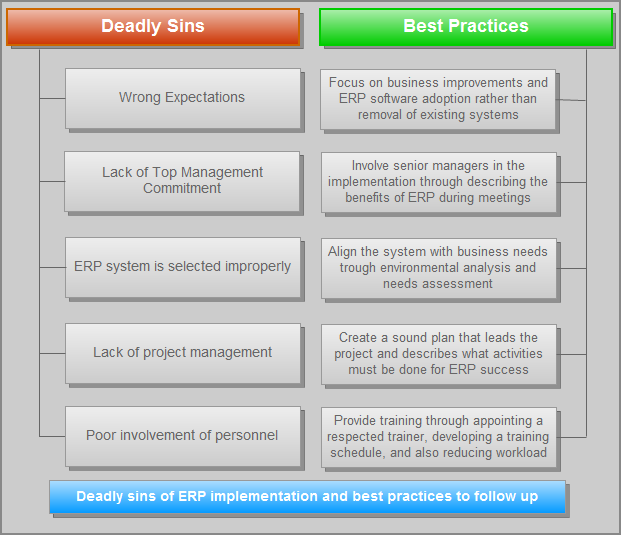Optimizing an ERP Implementation Project in 5 Steps
 The term “Enterprise Resource Planning” or ERP system has been widely used since the late ‘90s, and today perhaps it is hard to find a growing company that does not realize the advantages of implementing such a system into their business environment. The growing popularity of the solutions seems to be the trigger for businesses to start their ERP implementation projects.
The term “Enterprise Resource Planning” or ERP system has been widely used since the late ‘90s, and today perhaps it is hard to find a growing company that does not realize the advantages of implementing such a system into their business environment. The growing popularity of the solutions seems to be the trigger for businesses to start their ERP implementation projects.
A successful system implementation provides a range of benefits that ensure business agility along with process automation, cost reduction, real-time business reporting, enhanced collaboration, and more. However, statistics shows that about 60% of the projects are failed or not completed. Why is this so? What are the reasons? In this article we’ll try to answer these questions. We’ll talk about how you can reach success in optimizing your ERP project in 5 steps. The purpose of this article is to help businesses understand what deadly sins to avoid and what best practices to follow up when implementing an ERP system.
Step 1. Set Right Expectations for the Implementation Project
The most frequent mistake businesses make when planning for an ERP implementation project is setting wrong expectations regarding the results the system will produce. The point is that often companies focus too much on replacing existing systems rather than on deploying the new system and its capabilities. They expect to get something that could make their environment better and remove the outdated functionality. But they do not expect to get all benefits of ERP, and this is the problem.
Poor analysis and wrong understanding of the initial expectations regarding ERP software disallow the companies to identify and exploit improvement opportunities provided by the software. Their environments will not be ready for those opportunities, and thus they will most likely decide that their implementation projects are failed.
How to avoid this fault? I suggest you focus on future improvements rather than on the existing situation. The point is that you must optimize your business environment through tailoring your software system’s functionally to your business’s needs. The prime focus should be placed on finding the balance between the needs you have and the system functionality you want to implement into your environment. Note you have to measure process effectiveness and efficiency regularly during your project in order to adopt and optimize the system extensively.
Step 2. Gain Top Management Commitment
If the senior management of your organization is not strongly committed to your project, you are likely to fail with this project. Why? Because lack of commitment from company executives makes the implementation of any ERP system unnecessary and unreasonable. When the top managers do not actively participate in your project, they do not realize the benefits their business will gain from ERP. They would rather delegate the project to lower management levels, and thus the project would never have an adequate appraisal and needs assessment.
What to do in this case? I recommend you to hold several meetings with the company’s executives to explain them how the system will work and what benefits the business will gain. Also prepare a cost estimate of the project and keep telling about full capabilities of the ERP software. You must be very persuasive and focus the seniors on the benefits that will let the company operate more effectively and efficiently. When the meetings are completed and the backing is given, you must agree upon the governance role the executives will perform during the implementation.
Step 3. Select Right ERP System
Sometimes ERP implementation projects are failed because the systems do not match business needs. If you select a system that does not meet your business needs, your project is doomed to fail. In other words, poor software selection paves the way for project failure.
I recently talked about warning signals. Here I just want to say that there are several reasons of software project failure including:
- Lack of integration with business data
- Too much time and money are spent on system deployment, maintenance and updating
- Poor user collaboration provided by the system
- Inadequate staff training
- Lack of remote access
And respectively the optimization solutions will be:
- Be sure your software integrates mission-critical business data with business decisions
- Test the system against the collaboration functionality to ensure your workers are able to effectively collaborate and communicate with each other
- Identify how much training is required for your personnel
- Be sure the system supports user remote access
Step 4. Manage It as a Project
An ERP implementation is a large project that has an expensive scope of work. Managers often do not realize this, and as a result their projects are failed. Without a sound project plan it is impossible to successfully implement a system for enterprise resource planning.
The practices of project management regarding system deployment need to be effective and efficient. You must manage the initiative as a project. There should be a sound management strategy and also the team consisting of highly respected representatives from all departments and functions of your enterprise. Besides you must gain full commitment of your IT guys who will support the project and provide technical advice.
Step 5. Provide Staff Training
A new system implementation is a change that makes the existing environment responds to it in some way. For example, users have to learn to do their daily operations and tasks within the new environment. But employees may be overwhelmed with their routine tasks, so there are no employee time and especially desire to change something. And thus, if the users do not understand how the system operates, the ERP implementation project appears to be failing.
The way for you to optimize your ERP project is to provide adequate training to your personnel. First you must appoint a highly respected executive trainer who will manage the training process and guide other trainers. Then you need to make a training schedule that identifies date and time and also duration for training sessions. Remember, it is necessary to reduce employee workload during training sessions. Your employees should be provided with additional time for rest.
Summary
To sum up all the said above, I give an image that summarizes the deadly sins of ERP implementations and best practices to follow up for solving these sins.














